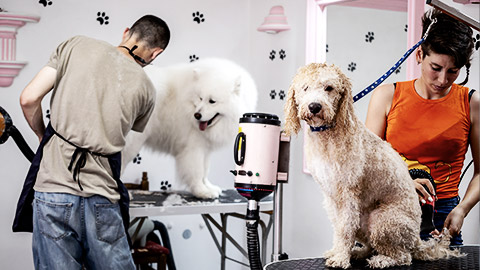As you will have come to learn, documentation is an integral part of working in the animal care industry. It is highly regulated therefore you need to ensure you have knowledge surrounding the documentation you will become exposed to.
Paperwork can be a labour-intensive task that never seems to end; however, paperwork is there for a reason and must be undertaken. In the case of an emergency, it may be a difference between life and death, or in the case of inspection, it may mean accreditation is lost or fines are issued. Documentation is not a task that should be overlooked and should be carried out carefully and with a degree of detail.
Let us look at the documentation in closer detail.
It is important to consider, there are several types of documentation that you will need to become familiar with and may be responsible for. Your organisation will have its own set of documents that are required to be completed at the end of each day, week or as required. Please ensure you check with your supervisor on the documentation you are responsible for.
The following table outlines some of the workplace documents in place in the animal care industry along with a definition and an example for each.
| Type of documentation | Definition | Example |
|---|---|---|
| Animal health records | Animal health records are similar to a patient card you would have at the doctor. |
They provide information on
|
| Pet labels | Pet labels are usually placed on the outside of the animal’s housing, cage, or enclosure when they are in boarding or vet/hospital stay overnight. |
The pet labels provide information on:
|
| Chemical register | The chemical register includes information about the types of chemicals that are used at the clinic or facility |
These registers will include:
|
| Diary | The diary keeps records of the appointments that have been booked for the day. The diary should be kept neat and legible as well as being in the same place for accessibility. Usually, a diary would be at the front desk near a phone to record appointment times or changes. |
Diary may include:
|
| Task completion | Depending on the place of work, task completions are a checklist of tasks that need to be carried out daily, weekly or monthly. |
These may include:
|
| Rosters | The roster will depend on the place of work and the availability of staff. Rosters are a way to keep the facility running smoothly and ensure there is enough staff to cover the job requirements of the day. Staff rosters are usually handed out individually and displayed in the common staff area. |
They include the following details:
|
| Timeframe records | ||
| Equipment use, damage and repair register | There is a lot of equipment used in animal care. You must be aware of what you are using and what to do if it is damaged and requires repair. |
|
| Facility damage and repair register | In the event of damage to the facility, there will need to be documentation completed to identify the damage and the process of repair |
Facility and damage repair may appear as:
|
| Incident reports | This type of documentation is one of the most important types of documentation. They are also one of the records that need to be kept for quite a long period. |
Incident reports are used for:
|
| Message recording systems | Most messages will be taken over the phone therefore you will need to ensure you have a pen and paper handy if there is no one to take the call. Messages can either be detailed or simple, however, they need to be followed up regardless of their nature. |
Message recording systems may include:
|
| Stock control records | The stock control records are also of high importance as they keep track of the supplies that are needed for the facility to operate effectively and safely. Staff need to ensure the stock records are kept up to date and regularly checked so replacement orders can be made. |
Stock control records are usually in the form of:
|
| Safe operating procedures | Safe operating procedures outline the parameters and expectations of employees, legal responsibilities. All staff must be across the safety and aware of what they are required to do to keep themselves and others safe. |
Safe operating procedures may include:
|
As you have just read in the table, there are several types of reporting that need to be considered. Your workplace will also have procedures in place for the reporting of animal welfare concerns. These procedures should be clearly explained to you upon commencing employment and you will be required to abide by them. There will be a specific type of documentation that will be required for reporting animal welfare incidents, and you will need to ensure you understand how to make the reports in addition to upholding your role in maintaining the animal’s welfare.
You must consider, however, serious issues such as medical emergencies will require an immediate verbal report to your supervisor and then followed up with a written report recounting the incident so it can be filed.
For some issues, the reporting may be as simple as updating a cage card or other document, form, or computer system. One example of simple reporting may be that of reporting damaging equipment.
Consider the following scenario.

Grooming
Kat and Troy work in the grooming section of Ark De Noah’s Pet Supplies. Kat, the head groomer, and the supervisor have recently carried out additional training with Troy with emphasis on reporting damaged equipment. Kat has noticed that some of the equipment such as the clippers are missing teeth from the blades however they have not been removed or tagged. Kat removed these from use and went to retrieve another pair of clippers which had the wires exposed, also not tagged, however, it was put away.
Kat explains to Troy any type of equipment that may be damaged or cannot be used needs to be tagged and removed from use until it can be replaced or fixed. This can be verbally carried out; however, it will also need to be documented to ensure it is followed up and the equipment can be substituted.
Kat shows Troy where to find the register for documenting damaged equipment and how to fill it out.
The following damaged equipment register is an example of how one of these documents is likely to be filled out. Remember, depending on your facility or clinic, these documents may look slightly different. You must know where to find them and how to fill them out appropriately.
| Date | Type of equipment | Damage description | Action taken | Follow up | Follow up action completion | Comments |
|---|---|---|---|---|---|---|
| 09.04.2020 | Dryer | Motor smoking | Dryer removed | Replace dryer and check if under warranty | Yes No | Dryer was covered under warranty and replaced by supplier |
| 10.10.2020 | Clippers |
|
Tagged and removed | Clippers to be replaced | Yes No | CLippers have not yet been replaced; however, they have been ordered |
| Yes No | ||||||
| Yes No | ||||||
| Yes No |

Updating records
In line with record protocols, not only will registers need to be regularly reviewed and updated, but there are also parameters around updating the records of the animals in care along with records of staff who are employed. When an animal has received treatment, it may have been a while between vet visits so the veterinarian will need to check their records to see what issues were recorded before this visit. These documents must be updated as they will need to know any of the following:
- what has happened
- what changes
- what the long-term plan is for the animal, whether this will be temporary medication or permanent.
Staff records also undergo updates, this is not limited to the animals. Staff working and living conditions may change, their records will need to be updated where appropriate. Staff records that are likely to be updated may include:
- name changes, if they are married
- changes to their employment contract
- emergency contact details
- address and so on.
Another fundamental aspect of documentation that you need to consider involves record-keeping. All documentation whether it has been made for staff or animals must be kept for a minimum of three years. Records are often very sensitive and must be kept confidential and not shared between other clients. Staff records should also be kept private and confidential and not discussed with other members of the team.
Records such as client medical records and profiles may be uploaded digitally rather than printed and written documents, however many practices continue to use written forms for record-keeping. Documents that are stored digitally must be kept organised and the device they are stored in must be password protected and backed up should anything go wrong with the computer system.
Written documents must be stored in a cabinet or drawers where staff are the only ones able to access the information and it too must not be discussed with other clients, to avoid a breach of privacy. No client should ever have access to these files at any time unless it is related to their own pet/ animal and has been discussed with the veterinarian. In addition, records may require additional intervention, for example, the professional opinion or examination of a specialist vet. In this case, the client must be advised and grant consent to this being shared. The details of the client such as the owner’s address should be kept confidential and not released without their consent.8
Some examples of written record forms are usually in the form of:
- reports
- checklists
- maintenance registers
- prescriptions
- health cards.
You must also consider if any records are to be released for any reason, consent from the client and permission sought by the veterinarian, supervisor, or owner of the practice before release.

